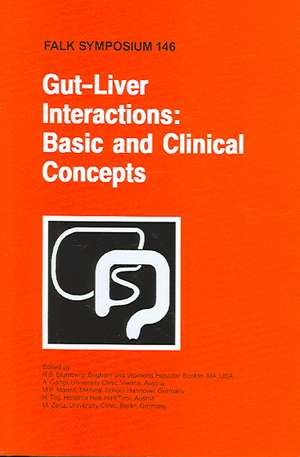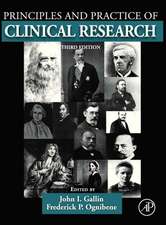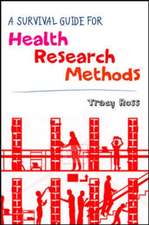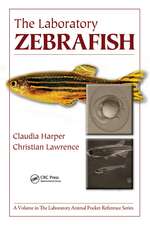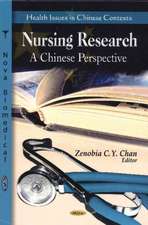Gut-Liver Interactions: Basic and Clinical Concepts: Falk Symposium, cartea 146
Editat de R. Blumberg, A. Gangl, M. P. Manns, H. Tilg, M. Zeitzen Limba Engleză Hardback – 15 noi 2005
Such intense interactions between gastroenterologists and hepatologists, as shown through this book, might boost and stimulate scientific ideas and research in other unexpected areas.
Din seria Falk Symposium
- 5%
 Preț: 1425.04 lei
Preț: 1425.04 lei - 5%
 Preț: 1092.06 lei
Preț: 1092.06 lei - 5%
 Preț: 1415.16 lei
Preț: 1415.16 lei - 5%
 Preț: 1419.56 lei
Preț: 1419.56 lei - 5%
 Preț: 1421.57 lei
Preț: 1421.57 lei - 5%
 Preț: 1418.68 lei
Preț: 1418.68 lei - 5%
 Preț: 1415.16 lei
Preț: 1415.16 lei - 5%
 Preț: 2124.15 lei
Preț: 2124.15 lei - 5%
 Preț: 1105.04 lei
Preț: 1105.04 lei - 5%
 Preț: 1103.95 lei
Preț: 1103.95 lei - 5%
 Preț: 2138.98 lei
Preț: 2138.98 lei - 5%
 Preț: 1108.72 lei
Preț: 1108.72 lei - 5%
 Preț: 1100.85 lei
Preț: 1100.85 lei - 5%
 Preț: 1105.40 lei
Preț: 1105.40 lei - 5%
 Preț: 716.28 lei
Preț: 716.28 lei - 5%
 Preț: 1101.21 lei
Preț: 1101.21 lei - 5%
 Preț: 1106.86 lei
Preț: 1106.86 lei - 5%
 Preț: 717.00 lei
Preț: 717.00 lei - 5%
 Preț: 1099.73 lei
Preț: 1099.73 lei - 5%
 Preț: 1100.09 lei
Preț: 1100.09 lei - 5%
 Preț: 1104.84 lei
Preț: 1104.84 lei - 5%
 Preț: 1422.31 lei
Preț: 1422.31 lei - 5%
 Preț: 1093.88 lei
Preț: 1093.88 lei - 5%
 Preț: 1105.77 lei
Preț: 1105.77 lei - 5%
 Preț: 1106.50 lei
Preț: 1106.50 lei - 5%
 Preț: 1094.44 lei
Preț: 1094.44 lei - 5%
 Preț: 1100.09 lei
Preț: 1100.09 lei - 5%
 Preț: 997.40 lei
Preț: 997.40 lei - 5%
 Preț: 996.07 lei
Preț: 996.07 lei - 5%
 Preț: 2111.16 lei
Preț: 2111.16 lei - 5%
 Preț: 1098.99 lei
Preț: 1098.99 lei - 5%
 Preț: 1099.94 lei
Preț: 1099.94 lei - 5%
 Preț: 1096.62 lei
Preț: 1096.62 lei - 5%
 Preț: 1411.54 lei
Preț: 1411.54 lei - 5%
 Preț: 1098.12 lei
Preț: 1098.12 lei - 5%
 Preț: 1415.16 lei
Preț: 1415.16 lei - 5%
 Preț: 1407.51 lei
Preț: 1407.51 lei - 5%
 Preț: 2112.10 lei
Preț: 2112.10 lei - 5%
 Preț: 2117.20 lei
Preț: 2117.20 lei - 5%
 Preț: 1423.58 lei
Preț: 1423.58 lei - 5%
 Preț: 1098.99 lei
Preț: 1098.99 lei - 5%
 Preț: 714.06 lei
Preț: 714.06 lei - 5%
 Preț: 1098.48 lei
Preț: 1098.48 lei - 5%
 Preț: 1098.84 lei
Preț: 1098.84 lei - 5%
 Preț: 1418.83 lei
Preț: 1418.83 lei - 5%
 Preț: 1913.14 lei
Preț: 1913.14 lei - 5%
 Preț: 1411.17 lei
Preț: 1411.17 lei - 5%
 Preț: 1794.27 lei
Preț: 1794.27 lei
Preț: 1101.21 lei
Preț vechi: 1159.17 lei
-5% Nou
Puncte Express: 1652
Preț estimativ în valută:
210.74€ • 228.83$ • 177.02£
210.74€ • 228.83$ • 177.02£
Carte tipărită la comandă
Livrare economică 22 aprilie-06 mai
Preluare comenzi: 021 569.72.76
Specificații
ISBN-13: 9781402041433
ISBN-10: 1402041438
Pagini: 302
Ilustrații: XVI, 302 p.
Dimensiuni: 155 x 235 x 23 mm
Greutate: 0.59 kg
Ediția:2006
Editura: SPRINGER NETHERLANDS
Colecția Springer
Seria Falk Symposium
Locul publicării:Dordrecht, Netherlands
ISBN-10: 1402041438
Pagini: 302
Ilustrații: XVI, 302 p.
Dimensiuni: 155 x 235 x 23 mm
Greutate: 0.59 kg
Ediția:2006
Editura: SPRINGER NETHERLANDS
Colecția Springer
Seria Falk Symposium
Locul publicării:Dordrecht, Netherlands
Public țintă
Professional/practitionerCuprins
Genetics and immunology in inflammatory bowel diseases.- Inflammatory bowel disease genotypes and phenotypes.- Abnormalities of cytokine regulation in the inflammatory bowel diseases.- Dendritic cells — key players in inflammatory bowel disease.- Lipids and inflammatory bowel disease: microsomal triglyceride transfer protein — the new dimension?.- The intestinal epithelium and inflammatory bowel disease.- Evidence-based treatment in inflammatory bowel diseases.- Evidence-based therapy with aminosalicylates.- The practical use of steroids in inflammatory bowel disease.- Immunosuppressants: clinical use and molecular mechanism of action.- Biologicals: old and new ones.- Difficult cases in inflammatory bowel diseases.- Management of extraintestinal disease in inflammatory bowel disease.- Innate immunity — microbial products.- Immunomodulatory properties of the gut microflora.- Defensins and other antimicrobial mediators.- Post-infectious irritable bowel syndrome: role of inflammation and gut flora.- Gut-liver interactions — basic and clinical aspects.- The liver and its contribution to induction of oral tolerance.- Molecular regulation of lymphocyte homing between the liver and the gut.- Modern concepts of coeliac disease pathogenesis.- Hepatobiliary manifestations in inflammatory bowel disease.- Primary biliar cirrhosis, cholestasis and autoimmune liver disease.- Primary biliary cirrhosis and biliary destruction: 2005; a liver odyssey.- Primary biliary cirrhosis: clinical aspects.- Molecular mechanisms of cholestasis.- Primary sclerosing cholangitis, alcoholic steatohepatitis, non-alchoholic steatohepatitis.- Basic concepts in primary sclerosing cholangitis — what can we learn from studies of its genetic basis.- Clinical concepts in primary sclerosingcholangitis.- Alcoholic liver diseases.- Should non-alcoholic fatty liver disease be treated differently in elderly patients?.- Liver failure and transplantation.- Acute liver failure — mechanisms of liver cell destruction.- Clinical management of acute liver failure.- Liver and bowel transplantation in 2005.- Established and novel methods for treating inflammatory diseases by inhibition of cytokines.
Textul de pe ultima copertă
The amount of information in the fields of gastroenterology and hepatology is dramatically increasing and the disciplines are drifting apart even though many clinical and scientific relevant issues need a very close interaction. In addition, scientific meetings are becoming more and more focused and therefore gastroenterologists and hepatologists are less frequently confronted together with challenging issues in their fields.
This book, the proceedings of the Falk Symposium No. 146 ‘Gut-Liver Interactions: Basic and Clinical Concepts’, held in Innsbruck, Austria, on March 11-12, 2005, brings together gastroenterologists and hepatologists both at a clinical and a basic scientific level. Topics have been structured in such a way to be of interest to both clinicians and basic scientists. The main focus of the book is to highlight the role of the immune system in gut and liver diseases and potential interactions of the gut and the liver respectively. Special emphasis is based on the importance of the gut flora in intestinal and also in liver diseases. The role of NOD2 is one of the very best examples demonstrating importance not only in inflammatory bowel diseases but also diseases well beyond this barrier.
One might hope that with a closer interaction between gastroenterologists and hepatologists in the future, beneficial therapies in either discipline might be more easily and rapidly introduced into the other field. Such intense interactions as shown through this book might boost and stimulate scientific ideas and research in other unexpected areas.
This book, the proceedings of the Falk Symposium No. 146 ‘Gut-Liver Interactions: Basic and Clinical Concepts’, held in Innsbruck, Austria, on March 11-12, 2005, brings together gastroenterologists and hepatologists both at a clinical and a basic scientific level. Topics have been structured in such a way to be of interest to both clinicians and basic scientists. The main focus of the book is to highlight the role of the immune system in gut and liver diseases and potential interactions of the gut and the liver respectively. Special emphasis is based on the importance of the gut flora in intestinal and also in liver diseases. The role of NOD2 is one of the very best examples demonstrating importance not only in inflammatory bowel diseases but also diseases well beyond this barrier.
One might hope that with a closer interaction between gastroenterologists and hepatologists in the future, beneficial therapies in either discipline might be more easily and rapidly introduced into the other field. Such intense interactions as shown through this book might boost and stimulate scientific ideas and research in other unexpected areas.
Caracteristici
Interdisciplinary symposium bringing together basic science and clinical applications Up-to-date research findings at the highest scientific level
